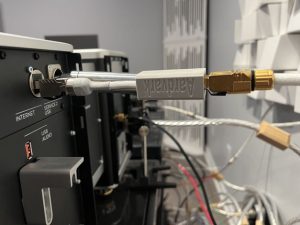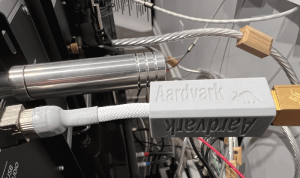AARDVARK ETHERNET ISOLATOR by Ron Cook

BACKGROUND
 For the last several years, the changes in my system have all been attributed, in one way or another, to tweaking! I have not changed components or loudspeakers, but I have changed speaker cables, AC powercords, and fuses. I also added the RevOpods into my audio rig to improve component isolation (reviewed here last year). As I look at these changes, they all have one significant thing in common: they all reduce various forms and sources of distortions. The result is a dramatic increase in realism, translating to a much more enjoyable listening experience. The Aardvark Ethernet Isolator now joins in the quest for sonic excellence through noise reduction. I have taken another step into 21st-century listening in the past year, using Qobuz to stream high-resolution downloads through my Memory Player.
For the last several years, the changes in my system have all been attributed, in one way or another, to tweaking! I have not changed components or loudspeakers, but I have changed speaker cables, AC powercords, and fuses. I also added the RevOpods into my audio rig to improve component isolation (reviewed here last year). As I look at these changes, they all have one significant thing in common: they all reduce various forms and sources of distortions. The result is a dramatic increase in realism, translating to a much more enjoyable listening experience. The Aardvark Ethernet Isolator now joins in the quest for sonic excellence through noise reduction. I have taken another step into 21st-century listening in the past year, using Qobuz to stream high-resolution downloads through my Memory Player.

THE AARDVARK
The function of the Aardvark is quite simple – to eliminate noise from the Ethernet line so that you hear more of the music. Easy to say, not so easy to do. If you want to read the manufacturer’s comments about how he has addressed the noise issue, please go to http://aardvark.com.ar. Since I admit that I am not a technical guy (especially when it comes to digital), I will confine my comments to what I hear rather than how it’s done.
By the way, I find the name for this little “sucker” (pun intended) entirely appropriate in that it sucks out digital nasties from the line, the way an actual aardvark sucks ants from the ground.
LISTENING
 I am going to take a somewhat different approach to this brief review, i.e., rather than elaborate on what I heard when I inserted the Aardvark into the system; I am going to focus on what I heard when I took it OUT (think about the great line from the Joni Mitchell classic tune “Big Yellow Taxi” when she sings Don’t it Always Seem to Go, that You don’t Know What You’ve Got till it’s Gone). When I received the Aardvark several months back, I immediately inserted it into the system. Installation took about 20 seconds since it involves removing the Ethernet wire from the back of the Memory Player, inserting the Aardvark in its place, and then inserting the Ethernet wire into the Aardvark. I immediately heard an improvement and decided to leave the Aardvark in place until I would write a review. For the next several months, I listened extensively to both files on the Memory Player and downloaded them via Quobuz using the Aardvark.
I am going to take a somewhat different approach to this brief review, i.e., rather than elaborate on what I heard when I inserted the Aardvark into the system; I am going to focus on what I heard when I took it OUT (think about the great line from the Joni Mitchell classic tune “Big Yellow Taxi” when she sings Don’t it Always Seem to Go, that You don’t Know What You’ve Got till it’s Gone). When I received the Aardvark several months back, I immediately inserted it into the system. Installation took about 20 seconds since it involves removing the Ethernet wire from the back of the Memory Player, inserting the Aardvark in its place, and then inserting the Ethernet wire into the Aardvark. I immediately heard an improvement and decided to leave the Aardvark in place until I would write a review. For the next several months, I listened extensively to both files on the Memory Player and downloaded them via Quobuz using the Aardvark.
When it was time to write this review, I decided to remove the Aardvark and then listen to remind myself what the sound was like before I installed it. Then, I would insert it again and compare it. Once I removed the Aardvark, I began by listening to some familiar material, and that’s when I had one of those OMG moments. I wouldn’t say that what I heard was unlistenable, but there was no doubt that I would not be listening to any streaming again without the Aardvark in place – it was that dramatic a change. Let me describe it.
 One of my favorite albums is “Act Your Age” by Gordon Goodwin’s Big Phat Band. I listen to this album frequently, not only for pleasure (the performances are great!!) but also because the recording might be the best representation of the sound of an actual big band I’ve heard to date. Thus, it also serves as an excellent tool for evaluating my system and any changes I make. In that context, my favorite track is titled Backrow Politics, the first track I listened to after removing the Aardvark. I immediately heard a collapse of the soundstage due to a tremendous reduction in “air” and an easily discerned flattening of the images of individual players who became more like cardboard cutouts.
One of my favorite albums is “Act Your Age” by Gordon Goodwin’s Big Phat Band. I listen to this album frequently, not only for pleasure (the performances are great!!) but also because the recording might be the best representation of the sound of an actual big band I’ve heard to date. Thus, it also serves as an excellent tool for evaluating my system and any changes I make. In that context, my favorite track is titled Backrow Politics, the first track I listened to after removing the Aardvark. I immediately heard a collapse of the soundstage due to a tremendous reduction in “air” and an easily discerned flattening of the images of individual players who became more like cardboard cutouts.
Then, when I returned the Aardvark to the system, it was like pumping air into a flat, deflated balloon, which brought back the 3D-like holistic images I had grown accustomed to. I was genuinely amazed by this difference.
Other improvements in the sound were consistent with the results I’ve had with other tweaks I’ve used over the years to reduce noise in the system. Imaging, image density, soundstage air, tonal colors, etc., are all improved, and these improvements are easily heard since the digital noise – that you didn’t know was there – no longer masks the critical details that let the music come alive. The result is that music downloads via Qobuz through the Memory Player now become very close in quality to that of stored files, so much so that the resulting sound is on a par –enjoyment wise – with any source.
CONCLUSION
The Aardvark is one device that changes things so much for the better that there is no going back once you experience the improvement.
Bear in mind that while the system’s performance with other sources remains unchanged (at a highly satisfying level), the Aardvark has now raised the performance of Qobuz downloads to near parity with any other source. This is a worthwhile achievement for me, given the quantity and variety of music available in this format.
As to its price, while beauty is in the eye of the beholder, the performance gains make the Aardvark seem like a steal, as I would no longer consider listening to music downloads without it.


Specifications:
Price: $449
Website: aardvark.com.ar
USA Distributor:
Liquid Hi-Fi, Charlotte, NC area
_____________________________________________________________________________________
Ron Cook’s System
Digital: Laufer Teknik Memory Player 64
Analog: VPI Aires TT, JMW Memorial tonearm, Benz Micro Ruby 2 cartridge, Behold phono stage
Amplification: Behold BPA-768 amplifier and APU-768 pre-amplifier
Loudspeakers: Tekton Ulfberht
Speaker Cables: Laufer Teknik Soliton
Accessories and Tweeks:
Puritan line conditioner
NanoFlo Superconductor Holographic 3D6 power cords
Kemp M100 AC conditioner
Frank Acoustics Power Bank
IPC Acoustic Energizers
Stein Music Harmonizers
HighEnd Novum PMR
Argent Room Lenses
Bybee IQSEs
QSA Silver and Red/black fuses
QSA electrical outlets
Stereo Times Masthead
Publisher/Founder
Clement Perry
Editor
Dave Thomas
Senior Editors
Frank Alles, Mike Girardi, Russell Lichter, Terry London, Moreno Mitchell, Paul Szabady, Bill Wells, Mike Wright, and Stephen Yan,
Current Contributors
David Abramson, Tim Barrall, Dave Allison, Ron Cook, Lewis Dardick, John Hoffman, Dan Secula, Don Shaulis, Greg Simmons, Eric Teh, Greg Voth, Richard Willie, Ed Van Winkle, Rob Dockery, Richard Doron, and Daveed Turek
Site Management Clement Perry
Ad Designer: Martin Perry






Be the first to comment on: AARDVARK ETHERNET ISOLATOR by Ron Cook